Inflate.
Rotate.
Evaluate.
How to maintain your tires

©2002
Why Tires Lose Pressure
Tires can lose on psi (pount per square inch) per month under normal conditions.
Additionally, tires can lose 1 psi for every 10° F temperature drop.
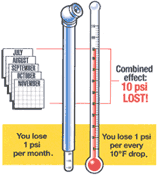
Just a look won't do it. One of these tires is actually ten pounds underinflated. your eyes can decieve you, so rely on a good tire gauge for an accurate reading.

30psi |

20psi |
Look for the manufacturer's recommended air pressure listed on the stickers of your vehicle's door jamb or owner's manual.
This chart shows you how underinflation can create an overload on tires.
Always check your air pressure to make sure it's up to standards, especially if you're carrying extra weight.
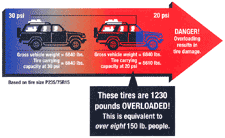
Lower pressure increases heat.
Infrared photography of tires tested at high speeds. Damaging heat increases inflation as pressure drops.

Air Pressure - Monthly Check
For accuracy, check your air pressure with a tire gauge when tires are cold.
Driving heats up tires and makes the reading incorrect.
 a) Remove tire valve cap. |
 b) Place the end of the tire gauge over the valve. |
 c) Press the tire gauge straight and firmly until the scale extends. |
 d) If needed, add air and recheck pressure with the tire gauge. |
 e) Replace valve caps. |
Tire Rotation
For maximum mileage, rotate your tires every 5,000 miles
Follow the correct rotation patterns.
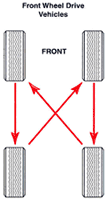 |
 |
Note: Some tires are "directional". Your tires may need to be rotated front to back, not side to side. These tires should have an arrow on the sidewall pointing in the correct direction of the rotation.
Tire Wear - Visual Check
Check for obvious signs of wear.
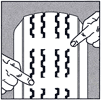 Exposed tread bars (replace) |
 Irregular shoulder wear (have inspected) |
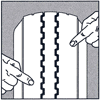 Shoulder wear (have inspected) |
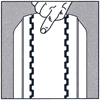 Center wear (have inspected) |
Place a penny in the tire as shown.
If you can see the top of Lincoln's head, the treads are worn and need replacing.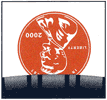
Inflate.
Check your tire pressure monthly.
Rotate.
Rotate tires every 5,000 miles.
Evaluate.
Routinely look for signs of tread wear or damage.
![]()